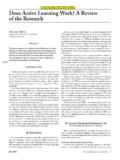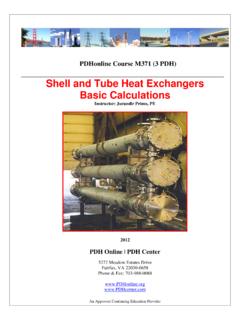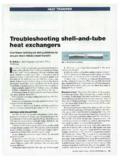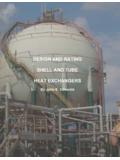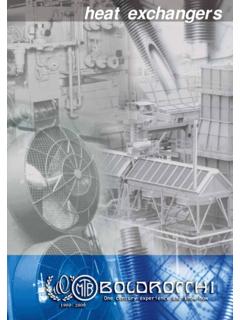Transcription of Heat Exchangers Rev 02 - Nc State University
1 114 heat Exchangers heat Exchangers transfer heat from one working fluid to another. For instance, steam generators, feedwater heaters, reheaters and condensers are all examples of heat Exchangers found in nuclear power systems. The heat transfer rate across a heat exchanger is usually expressed in the form mTUAQ =& (1) where: Q& = heat transfer rate U = overall heat transfer coefficient A = heat exchanger area mT = average temperature difference between the fluids The overall heat transfer coefficient is a function of the flow geometry, fluid properties and material composition of the heat exchanger . The average temperature difference between the fluids is in general a function of the fluid properties and flow geometry as well.
2 heat exchanger design requires consideration of each of these factors. Overall heat Transfer Coefficient The overall heat transfer coefficient represents the total resistance to heat transfer from one fluid to another. The functional form of U or the product UA, may be derived for any particular geometry by performing a standard conduction analysis on the system of interest. To illustrate this, consider first a planar wall of thickness L, subject to convection on both sides. Figure 1: Planar Wall heat exchanger The heat transfer rate from the hot fluid to the wall for a surface area defined by the length segment z is given by Newton s Law of Cooling as []11 TTAhqHsc = (2) such that scHAhqTT11= (3) LTTHCzz+ zTT12 115 The temperature drop across the wall is found by solution of the conduction equation 0= dxdTkdxd (4)
3 Subject to the boundary condition sAqdxdTk= 0 (5) Integrating Equation 4, 00= dxdxdTkdxdx (6) 00= dxdTkxddTk (7) and applying the boundary condition gives 0=+ sAqxddTk (8) Integrate Equation 8 over the wall thickness to obtain the temperature drop across the wall 000= + LsLxdkAqxdxddT (9) skAqLTT= 21 (10) The temperature drop from the wall to the cold fluid is also found from Newton s Law of Cooling, similar to Equation 3 above scCAhqTT22= (11)
4 Adding Equations 3, 10, and 11 gives the temperature drop from the hot to cold fluid as ++= 2111ccsCHhkLhAqTT (12) or ][CHsTTUAq = (13) where 116 12111 ++ cchkLhU (14) is the Overall heat Transfer Coefficient. In actual heat exchanger design, the planar wall is seldom used. A more common design involves heat transfer across a tube wall as illustrated in Figure 2. Figure 2. Circular Tube heat exchanger In this case, the heat transfer rate from the hot fluid to the wall within the length segmentz is []112 TTzrhqHic = (15) such that zrhqTTicH = 211 (16) For the tube wall, the conduction equation is 01= drdTrkdrdr (17) subject to the boundary condition qdxdTzrkir= 2 (18)
5 Integrating Equation 17, 0= drdrdTrkdrdrri (19) TTHCzz+ zTT12rrior = 0 117 0= irdrdTkrrddTkr (20) and applying the boundary condition gives 02= + zqrddTkr (21) Integrate Equation 21 over the wall thickness to obtain the temperature drop across the wall 02= + oioirrrrrrdzkqrdrddT (22) = iorrzkqTTln221 (23) The temperature drop from the wall to the cold fluid is zrhqTTocC = 222 (24) Adding Equations 16, 23, and 24 gives the temperature drop from the hot to cold fluid as + + = 2121ln2121coiociCHhrrrkhrzqTT (25) or ][CHTTUAq = (26)
6 Where 12121ln2121 + + coiocizhrrrzkzhrUA (27) Since the heat transfer area on the interior of the tubes is different from that on the exterior in cylindrical geometry, the product UA is normally used to describe heat exchanger performance. Equations 13 and 26 represent the heat transfer across a small length segment z where the hot and cold fluid temperatures can be considered constant. In reality, the hot and cold fluid temperatures change continuously along the length of the heat exchanger as illustrated in Figure 3 below for the Double Pipe heat exchanger given in Figure 4. 118 Figure 3: Fluid Temperature Profiles in a Double Pipe heat exchanger If we let z be a differential length, then the heat transfer across the differential length segment is )(CHTTUdAQdq ==& (28) where dA is the differential area associated with length dz.
7 The total heat transferred across the heat exchanger is then obtained by integrating Equation 28 over the length of the heat exchanger =2121)(CHTTUdAQd& (29) mTUAQ =& (30) where 21)(1dATTATCHm (31) is the average temperature difference between the hot and cold fluids over the length of the heat exchanger . Since the area in Equation 30 is now the total area of the heat exchanger instead of that associated with a small length segment of a single tube, the expression given for UA in Equation 27 is modified to reflect the actual area of the heat exchanger ooioiiAhrrkLAhnUA1ln211+ += (32) where.
8 N = number of tubes TTTThc11hc22qdA12 AParallel FlowCounter FlowTh2Tc2dAA21Th1Tc1q 119 hi = convective heat transfer coefficient on the tube interior Ai = interior surface area of one tube ho = convective heat transfer coefficient on the tube exterior Ao = exterior surface area of one tube ri = tube inner radius ro = tube outer radius k = tube thermal conductivity L = tube length The value of mT depends on the heat exchanger design, with analytic expressions only available in special cases. One such case is that of the simple double pipe heat exchanger illustrated below. Figure 4: Double Pipe heat exchanger Log Mean Temperature Difference We wish to calculate the total heat transfer in the double pipe heat exchanger through an expression of the type mTUAQ =& where mT is some appropriate average temperature difference between the hot and cold fluids. If we assume parallel flow, the steady State heat transferred through a differential area dA is ()()ccphhpdTCmdTCmQd&&&= = (33) where the subscripts h and c denote the hot and cold fluids respectively.
9 We have already seen that we can write the heat transfer across this differential area in terms of the Overall heat Transfer Coefficient as )(chTTUdAQd =& (34) From Equation 33, ()hphCmQddT&& = and ()cpcCmQddT&&= such that ()() + = = cphpchchCmCmQdTTddTdT&&&11)( (35) 120 Substitute for Qd& from Equation 34 ()() + = cphpchchCmCmUdATTTTd&&11)()( (36) Assuming all terms on the right hand side of Equation 36 are constant, we can integrate from point (1) to point (2) along the length of the heat exchanger ()() + = 212111)()(cphpchchCmCmUdATTTTd&& (37) ()()() + = cphpchCmCmUATT&&11ln21 (38) ()()()() + = cphpchchCmCmUATTTT&&11ln12 (39) We further take advantage of the fact ()()()()1221cccphhhpTTCmTTCmQ = =&&& (40) such that ()()QTTCmQTTC mcccphhhp&&&&12211 and 1 = = (41) Substituting into Equation 39 ()()()()
10 []122112lncchhchchTTTTQUATTTT + = & (42) and rearranging gives ()()()()[]mchchchchTUATTTTTTTTUAQ = =11221122/ln& (43) where ()()()()[]11221122/lnchchchchmTTTTTTTTT (44) is called the Log Mean Temperature Difference (LMTD). The LMTD represents the effective, average temperature difference between the two heat transfer fluids over the length of the heat exchanger and though derived here for parallel flow, Equation 44 is also valid for counter flow heat Exchangers . The LMTD given in Equation (44) is only strictly valid for single phase fluids in double pipe heat Exchangers .
